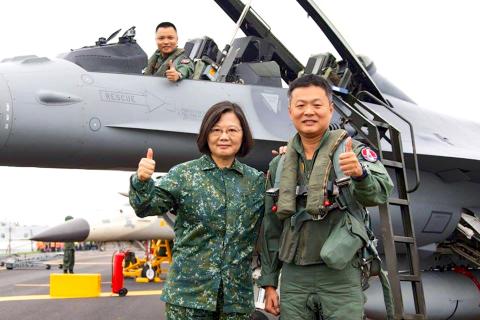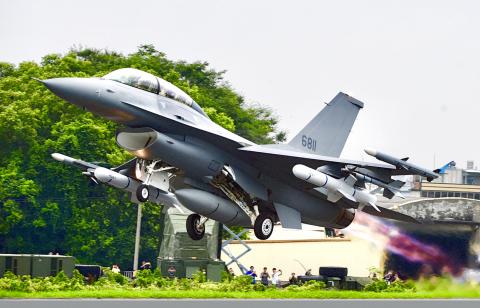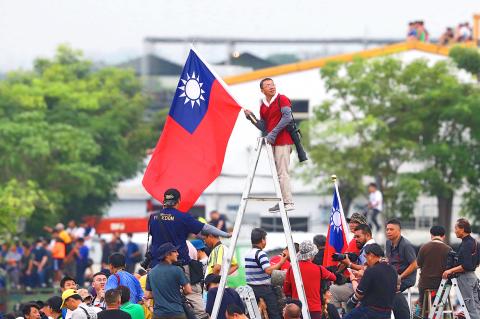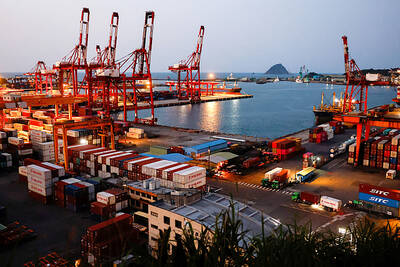The military yesterday displayed how its fighter jets can land, refuel and rearm on the nation’s highways for the first time in five years as part of the annual Han Kuang military exercises simulating defense against a Chinese invasion.
On Monday, the streets across northern Taiwan were briefly deserted as authorities carried out an annual missile drill, with text messages sent to every mobile phone and air raid sirens wailing.
Yesterday, 1,600 soldiers were mobilized in central Taiwan as aircraft practiced landing on a closed section of highway for the annual exercises.

Photo: Military News Agency
Three fighter jets, as well as an early warning aircraft, practiced refueling and loading missiles and other ammunition before taking off again.
An F-16V jet, a Mirage 2000-5, an Indigenous Defense Fighter and an E-2K airborne early warning aircraft landed on the Huatan section of the Sun Yat-sen Freeway (Freeway No. 1) in Changhua County at about 6am.
It was the first time an F-16V took part in the exercises.

Photo: Peter Lo, Taipei Times
The military is upgrading its 144 F-16A/B jets to F-16Vs as part of a US$3.68 billion project launched by the government in 2016.
The retrofit program involves installing advanced equipment on the fighters, including the AN/APG active electronically scanned array radar system used in the US’ F-22 and F-35 jets.
The comprehensive upgrade of the air force’s entire F-16 fleet is expected to be completed by the end of 2023, the air force has said.

Photo: CNA
“There are only a few military air bases [in Taiwan], which would become prime targets in the event of an attack. The highway drill is necessary, as highway strips would be our priority choice if the runways are damaged during a war,” air force Colonel Shu Kuo-mao (許國茂) told reporters.
Taiwan would be massively outgunned in terms of troop numbers and firepower in any war with China, but it has developed sophisticated asymmetric tactics to hold out for as long as possible and make any invasion of the nation very costly for Beijing.
President Tsai Ing-wen (蔡英文), who inspected the drill, commented on increased Chinese naval and air force patrols around Taiwan over the past few months.
“They have caused a certain degree of threat to regional peace and stability. We should maintain high vigilance,” Tsai said.
The exercises aim to test combat capabilities of all branches of the armed forces in the face of a continuing military threat from China.
They came after the US, Japan, South Korea and Australia last week launched operation “Pacific Vanguard” near Guam, bringing together more than 3,000 sailors from the four countries.
Beijing has also been angered by warming relations between Taipei and Washington since Tsai came to power in May 2016.
On Monday, Beijing reacted frostily to photographs showing a rare meeting between uniformed Taiwanese officers and their US counterparts earlier this month.
Last week, China lodged a protest with Washington after two US warships sailed through the Taiwan Strait.
Additional reporting by CNA

US President Donald Trump yesterday announced sweeping "reciprocal tariffs" on US trading partners, including a 32 percent tax on goods from Taiwan that is set to take effect on Wednesday. At a Rose Garden event, Trump declared a 10 percent baseline tax on imports from all countries, with the White House saying it would take effect on Saturday. Countries with larger trade surpluses with the US would face higher duties beginning on Wednesday, including Taiwan (32 percent), China (34 percent), Japan (24 percent), South Korea (25 percent), Vietnam (46 percent) and Thailand (36 percent). Canada and Mexico, the two largest US trading

China's military today said it began joint army, navy and rocket force exercises around Taiwan to "serve as a stern warning and powerful deterrent against Taiwanese independence," calling President William Lai (賴清德) a "parasite." The exercises come after Lai called Beijing a "foreign hostile force" last month. More than 10 Chinese military ships approached close to Taiwan's 24 nautical mile (44.4km) contiguous zone this morning and Taiwan sent its own warships to respond, two senior Taiwanese officials said. Taiwan has not yet detected any live fire by the Chinese military so far, one of the officials said. The drills took place after US Secretary

CHIP EXCEPTION: An official said that an exception for Taiwanese semiconductors would have a limited effect, as most are packaged in third nations before being sold The Executive Yuan yesterday decried US President Donald Trump’s 32 percent tariff on Taiwanese goods announced hours earlier as “unfair,” saying it would lodge a representation with Washington. The Cabinet in a statement described the pledged US tariffs, expected to take effect on Wednesday next week, as “deeply unreasonable” and “highly regrettable.” Cabinet spokeswoman Michelle Lee (李慧芝) said that the government would “lodge a solemn representation” with the US Trade Representative and continue negotiating with Washington to “ensure the interests of our nation and industries.” Trump at a news conference in Washington on Wednesday announced a 10 percent baseline tariff on most goods

THUGGISH BEHAVIOR: Encouraging people to report independence supporters is another intimidation tactic that threatens cross-strait peace, the state department said China setting up an online system for reporting “Taiwanese independence” advocates is an “irresponsible and reprehensible” act, a US government spokesperson said on Friday. “China’s call for private individuals to report on alleged ‘persecution or suppression’ by supposed ‘Taiwan independence henchmen and accomplices’ is irresponsible and reprehensible,” an unnamed US Department of State spokesperson told the Central News Agency in an e-mail. The move is part of Beijing’s “intimidation campaign” against Taiwan and its supporters, and is “threatening free speech around the world, destabilizing the Indo-Pacific region, and deliberately eroding the cross-strait status quo,” the spokesperson said. The Chinese Communist Party’s “threats